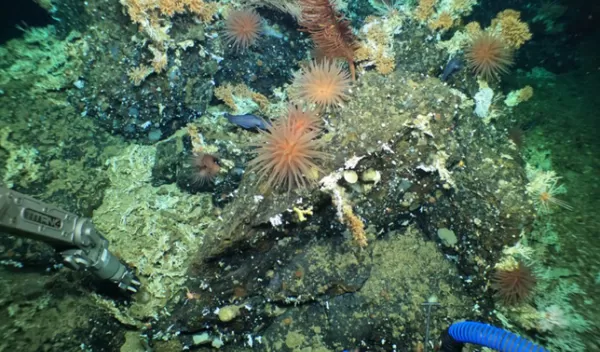
Scientists discover pristine deep-sea coral reefs in the Galápagos Marine Reserve
Scientists have discovered extensive, ancient deep-sea coral reefs in the Galápagos Marine Reserve — the first of their kind to be documented inside the marine protected area since it was established in 1998. The reefs, found at a depth of 400-600 meters (1,310-1,970 feet), are at the summit of a previously unmapped seamount in the central part of the archipelago and, said the researchers, support a breathtaking mix of deep marine life.
Daniel Fornari, a marine geologist at the Woods Hole Oceanographic Institution, is a co-lead of the U.S. National Science Foundation-supported expedition. The expedition includes scientists at Boise State University and is in collaboration with the Galápagos National Park Directorate, Charles Darwin Foundation and the Ecuadorian Navy's Oceanographic and Antarctic Institute. The expedition is also funded by the Natural Environmental Research Council in the U.K.
Gail Christeson, a program director in NSF's Division of Ocean Sciences, said, "The discovery of this new and healthy reef illustrates the importance of international collaborations to map and image unexplored regions of the seafloor."
Cresting the ridge of an unmapped submerged volcano, and stretching over several kilometers, the impressive reef structure was first recorded by scientists Michelle Taylor of the University of Essex in the U.K. and Stuart Banks of the Charles Darwin Foundation in Ecuador while diving in the human-occupied vehicle Alvin.
The observations are the first of a deep-sea coral reef in the Galápagos Marine Reserve. Alvin recently completed upgrades that included improved high-quality still and ultra-high definition 4K video imaging systems, as well as enhanced sampling capabilities, which allowed for stunningly clear video of the newly discovered reef sites, as well as the delicate sampling of the reefs required.
"Exploring, mapping and sampling the Galápagos Platform is an opportunity to apply 21st-century deep-submergence and seafloor mapping technologies and innovative deep-sea imaging techniques to reveal the beauty and complexity of the volcanic and biological processes that make the Galápagos so unique," said Fornari, who has mapped and sampled the marine environment in the Galápagos for more than 20 years.
Commenting on the discovery, the Minister of Environment of Ecuador, Jose Antonio Dávalos, said, "This is encouraging news. It reaffirms our determination to establish new marine protected areas in Ecuador and to continue promoting the creation of a regional marine protected area in the Eastern Tropical Pacific.
"The richness of the depths of our as yet unexplored ocean is another reason to strive toward achieving the commitments of the Global Ocean Alliance 30x30, which aims to protect at least 30% of the world's oceans by 2030, aligning sustainable economic activities with conservation."


